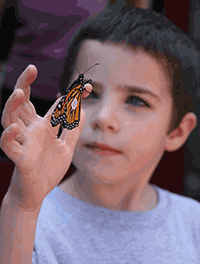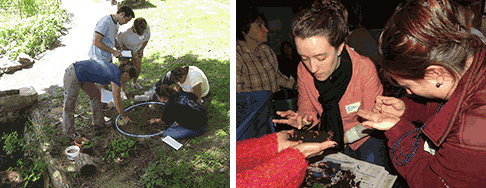Engage Students in Schoolyard Habitats
 Once your schoolyard habitat is in place, utilizing the space with your students can seem intimidating. The following organizations offer a variety of tricks and tips on taking student learning outdoors. Click on the links below to learn more.
Once your schoolyard habitat is in place, utilizing the space with your students can seem intimidating. The following organizations offer a variety of tricks and tips on taking student learning outdoors. Click on the links below to learn more.
- Photo By: Caroline Blizzard, Maryland State Parks
Lesson Plans and Activities
The following websites link to specific lesson plans or examples of ways in which teachers have successfully utilized outdoor spaces. Consider these websites a source of inspiration; they represent just a small fraction of the ways in which schoolyard habitats and outdoor spaces can be used as learning environments.
Elementary School (Grades K-5)
Middle School (Grades 6-8)
High School (Grades 9-12)
The
Project WILD,
Project WET,
Project Learning Tree, and
Growing Up WILD environmental education training programs are offered to educators throughout the state of Maryland. Upon completion of these programs, educators receive comprehensive guides that contain a variety of lesson plans, many with activities that can be completed in conjunction with schoolyard habitats. Educators may be eligible for Maryland State Department of Education (MSDE) credit. The following websites provide links to activities that include schoolyard habitat connections and the associated curriculum standards these activities meet. For more information, please contact Sarah Witcher ([email protected]).

Educators engaged in professional development workshops by Elaine Raesly and Kerry Wixted
Community Science Projects
Community science projects are research projects named for the way in which they engage individuals beyond the professional scientific community. Communit science projects provide a great way for students to participate in hands-on, real-life science; and many of these projects can be completed in schoolyard habitats. Below are various projects that teachers and students can take part in.
-
BumblebeeWatch
Participants track bumblebees all across North America to assist in research and conservation efforts -
eMammal
Participants document mammals throughout the mid-Atlantic region to assist in research -
FrogWatch
Participants submit reports on the calls of frogs and toads to assist in research and conservation efforts -
Great Sunflower Project
Participants lead pollinator counts to assist in research and conservation efforts -
Maryland Biodiversity Project
Participants submit records of species in their area to assist with an online catalogueof all living species found in Maryland -
Monarch Watch
Participants tag and release butterflies, collect seeds, and plant milkweed to assist in research and conservation efforts -
Project BudBurst
Participants track the timing of various plant phases to assist in research -
Project FeederWatch
Participants track birds that visit feeders in the winter to assist with research -
Project Noah
Participants submit records of species in their area, sharing observations, photos, etc.